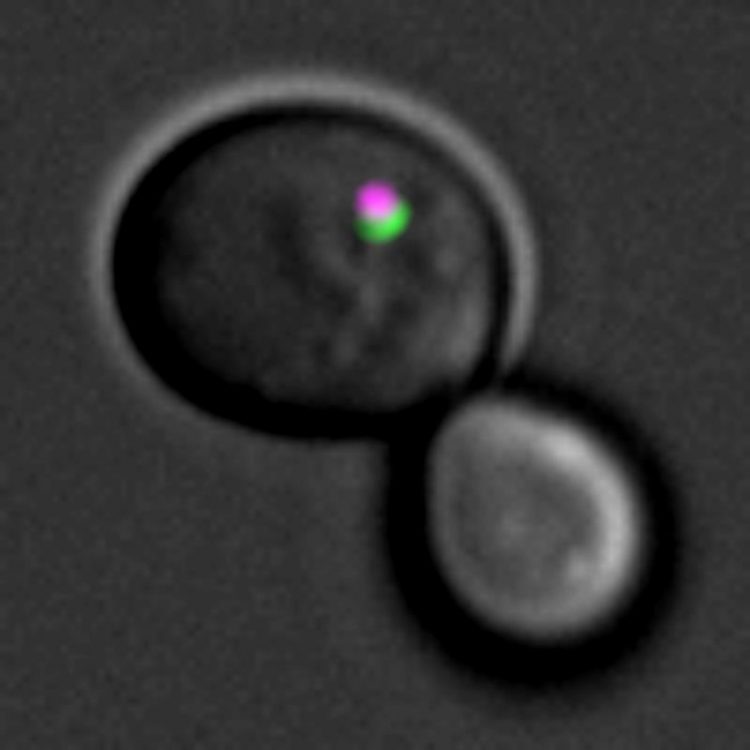Tiny Helpers that Clean Cells

Cellular waste (magenta) is engulfed by autophagic membranes (green) in a yeast cell, monitored by live-cell fluorescence microscopy. Source: Claudine Kraft
Cells collect, decompose and recycle surplus or damaged cell material. This process, known as autophagy, is important, because cellular waste can be harmful to the entire organism if it accumulates in the cells. Like the treatment of household waste, autophagy requires certain mechanisms and elements.
A team led by Prof. Dr. Claudine Kraft from the Institute of Biochemistry and Molecular Biology at the University of Freiburg and Levent Bas from the Institute of Biochemistry and Cellular Biology at the University of Vienna in Austria has made new findings on the role of proteins in the amalgamation of autophagosomes and vacuoles which have now been published in the latest edition of the Journal of Cell Biology (JCB).
During the process of autophagy, damaged cellular components, unused proteins and other cellular waste are incorporated into a vesicle, called the autophagosome, rather like how domestic waste is packed up in bin bags. In mammals the vesicles are transported to a lysosome, or in yeasts and plants to vacuoles, the cell organelles.
These organelles have a similar function to a recycling plant: they decompose the materials included with the autophagosomes, so that the individual components can be reused. Numerous proteins initiate and regulate the process in the cells: more than 40 different types have already been identified.
However their molecular functions are still largely unknown. Also, until now it has not been understood how the autophagosomes fuse with vacuoles so that the cellular waste can be recycled.
In her latest publication the Freiburg biochemist offers a possible explanation: in order to understand what is needed for the fusion of the autophagosomes and vacuoles, Kraft and Bas and their team have traced the process in the laboratory. They segregated vacuoles, autophagosomes and intracellular liquid from yeast cells and created an environment in which the fusion could be observed in vitro, that is, outside a living organism.
In general, membrane fusions require four bundled proteins known as SNARE proteins. Kraft and her colleagues have now managed to confirm that the fusion of the autophagosomes and vacuoles is also a process driven by SNARE proteins and that three already-known SNAREs are operative in the fusion process.
They also discovered the fourth necessary SNARE, now called Ykt6. These results help to understand autophagy and its underlying molecular processes better. And thanks to their newly-developed in-vitro approach, in future it will be possible to identify other proteins that operate in the fusion process.
Original publication:
Levent Bas, Daniel Papinski, Mariya Licheva, Raffaela Torggler, Sabrina Rohringer, Martina Schuschnig, and Claudine Kraft (2018): Reconstitution reveals Ykt6 as the autophagosomal SNARE in autophagosome-vacuole fusion. In: Journal of Cell Biology. DOI: 10.1083/jcb.201804028
Prof. Dr. Claudine Kraft
Institute of Biochemistry and Molecular Biology
University of Freiburg
Tel.: 0761/203-5221
e-mail: claudine.kraft@biochemie.uni-freiburg.de
DOI: 10.1083/jcb.201804028
http://www.pr.uni-freiburg.de/pm-en/online-magazine/research-and-discover/cellul…
http://www.pr.uni-freiburg.de/pm-en/press-releases-2018/tiny-helpers-that-clean-…
Media Contact
All latest news from the category: Life Sciences and Chemistry
Articles and reports from the Life Sciences and chemistry area deal with applied and basic research into modern biology, chemistry and human medicine.
Valuable information can be found on a range of life sciences fields including bacteriology, biochemistry, bionics, bioinformatics, biophysics, biotechnology, genetics, geobotany, human biology, marine biology, microbiology, molecular biology, cellular biology, zoology, bioinorganic chemistry, microchemistry and environmental chemistry.
Newest articles

First-of-its-kind study uses remote sensing to monitor plastic debris in rivers and lakes
Remote sensing creates a cost-effective solution to monitoring plastic pollution. A first-of-its-kind study from researchers at the University of Minnesota Twin Cities shows how remote sensing can help monitor and…

Laser-based artificial neuron mimics nerve cell functions at lightning speed
With a processing speed a billion times faster than nature, chip-based laser neuron could help advance AI tasks such as pattern recognition and sequence prediction. Researchers have developed a laser-based…

Optimising the processing of plastic waste
Just one look in the yellow bin reveals a colourful jumble of different types of plastic. However, the purer and more uniform plastic waste is, the easier it is to…



